Matador Network's Blog, page 711
January 27, 2021
Japan's soba-mae, pre-soba ritual
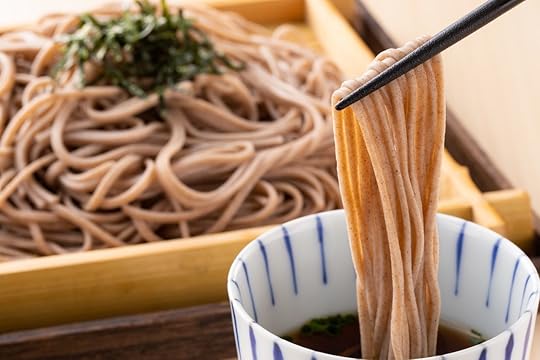
In the United States, a quick meal at a bar typically starts with a beer, cocktail, or glass of wine and a small appetizer. The ritual has no name, formal or otherwise, though a cocktail-minded or worldly person in your group may insist on calling the drink an aperitif. These before-dinner rituals are a little more specific in Japanese soba restaurants. The pre-meal drink and snack is called soba-mae, and it’s an important part of any soba eating experience.
Soba-mae translates literally to “before soba.” Today, you can find a variety of drinks served during the soba-mae portion of the meal, from sake to whisky highballs. Nori, a type of dried seaweed, is an always welcome snack, though which small bites are served depends on where you’re eating. Soba-mae is a tradition that’s continued with rising and falling popularity for centuries.
Soba means buckwheat. Researchers believe buckwheat was originally domesticated in Yunnan Province, China, and made it to the Korean peninsula and then Japan. The first written record of buckwheat in Japan dates to the eighth century when it was cultivated in between the growing seasons of other crops, while the first written record of sobagiri (which translates to cut soba) appeared in the mid-1500s. Buckwheat is hardy and easy to grow, making it the perfect choice for a catch-crop grown in tough soil or during droughts, according to Japan Times.
In the modern era, most soba noodles are noodles made from buckwheat flour — buckwheat lacks gluten because it’s a seed rather than a wheat or grain, so the noodles are typically formed with the addition of wheat flour or another binder.
The Edo Period between the early 1600s and mid-1800s saw a rise in the popularity of soba noodles. Ni-hachi soba, made with 80 percent soba flour and 20 percent wheat flour, was popular at the time because that combination made the noodles easier to prepare, and it’s still the preferred ratio for many producers.
At the time, soba was served fresh, but diners had to wait while the noodles were prepared. Drinks and snacks were served to pass the time and prepare eaters’ taste buds for the flavors of the soba that they were waiting for. Sake, kamaboko (seafood), and tamagoyaki (a rolled omelet) were popular choices, according to the Japanese soba restaurant and shop Kamaboko. Thus, the soba-mae tradition was born.
The regions that were once famous for buckwheat — Nagano Prefecture and Hokkaido — are still well known for the crop and responsible for most of the domestic production, though the vast majority of buckwheat used in Japan is imported from China, the US, and Canada. Soba’s popularity waxed and waned over the centuries, but it’s once again on the rise and bringing the tradition of soba mae along with it. Today, there are some 24,000 soba restaurants in Japan, according to Discover Japan.
Your selection of soba-mae options varies. There are of course nori and traditional kamaboko snacks served alongside sake. Relatively modern drinks have fallen into the fold of soba-mae, as well, such as the whisky highball. During a virtual soba making class with cookbook author and instructor Sonoko Sakai, highballs made with Suntory’s Toki Japanese whisky were the drink of choice. The highball — typically made with one part whisky to three parts soda water — became a popular bar drink in the 2000s, House of Suntory brand ambassador Jonathan Armstrong says, because it’s the perfect informal after-work drink.
Regardless of what you choose to drink and snack on before your bowl of soba arrives, embrace the selection of small bites beforehand. Your soba will simply feel more complete with the addition of soba-mae. 
The post To fully enjoy Japanese soba noodles, partake in soba-mae appeared first on Matador Network.

Emperor Augustus’ tomb in Rome open

Rome certainly has no shortage of attractions to draw visitors from all over the world, but now it’s adding one more to its already impressive roster. The tomb of Augustus, the first emperor of Rome, will finally reopen to the public after a 13-year restoration process. It has largely been closed for the past 80 years, with the exception of brief periods of opening.
The Mausoleo di Augusto is the largest circular tomb of the ancient world, at 295 feet in diameter and 147 feet in height. It’s served many different purposes throughout history, apart from its function as a tomb, including a medieval fortress, an amphitheater, a concert hall, and a bullfighting and jousting ring.
Augustus, who was born in 63 BCE, ordered work on the tomb to begin in 28 BCE after his victory over Mark Antony and Cleopatra. Although built to house the emperor and his family, the tomb was nearly as large as nearby Pincian Hill. Today, only a third of the original structure remains.
Restorations were completed in two stages and cost over $12 million. The burial space has been restored, a spiral staircase leading to the monument’s roof has been reconstructed, and the area has been landscaped appropriately. Even the Piazza Augusto square outside the mausoleum is being updated.
The mausoleum will open on March 1, 2021, with tickets free to the public until April 21. Due to the pandemic, tickets will be for designated 50-minute time slots to avoid overcrowding. 
The post The tomb of Augustus, Rome’s first emperor, is opening this spring appeared first on Matador Network.

January 26, 2021
Winter wellness in Quebec City
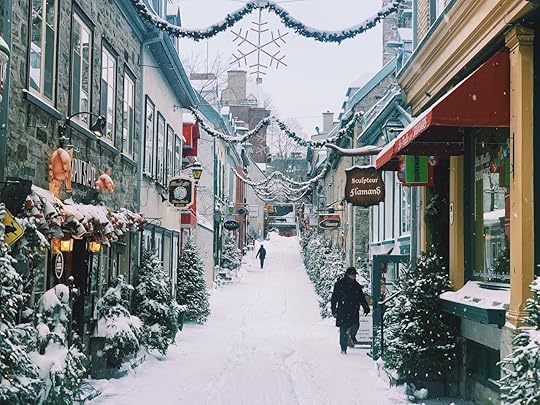
Editor’s note: Due to the COVID-19 pandemic, international travel to Canada is limited, and many indoor dining options and activities are not available. However, that gives you plenty of time to plan in advance for the 2021-22 winter season. Consider booking during the holidays or the annual Winter Carnival for an extra magical experience in Quebec City.
It’s a common misconception that winter means hunkering down and ticking off the days until spring. Cold weather can feel like a challenging adversary, but winter can actually be the perfect time to physically and mentally reset. You just have to embrace the cold. There’s no better place to do that than Quebec, Canada, a destination practically synonymous with its cold-weather delights. If you’ve set new year’s resolutions to go vegan, exercise more, or step outside of your comfort zone, Quebec allows you to commit to these resolutions while on a vacation — and then break them over a warming bowl of decadent poutine. From unwinding at a spa in the Eastern Townships to sleeping in an ice hotel outside of Quebec City, here’s everything you need to do in Quebec to rejuvenate your mind and body surrounded by snowfall.
Plunge between hot and cold at Spa Eastman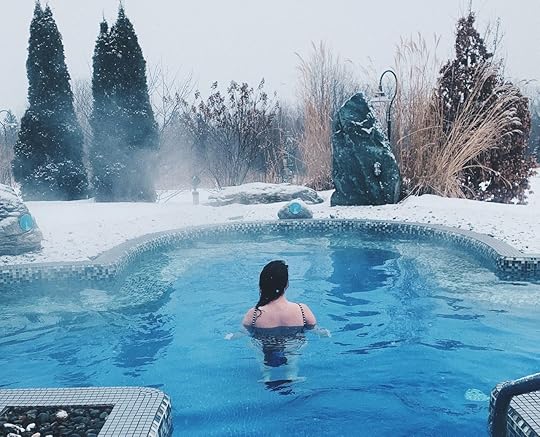
Photo: Laura Reilly
Begin your trip by traveling further into the province than most tourists go, to the wooded and reliably snowy Eastern Townships. Check into Spa Eastman, a small but luxurious wellness resort set on over 350 acres where opportunities for peace and quiet abound. Plan to spend at least two nights here or you won’t have enough time to take advantage of all of the inclusive activities or properly unwind. Booking a treatment at the spa is non-negotiable; consult with the staff in advance on your specific preferences or ailments, and they’ll recommend a uniquely suited treatment that’s more dynamic than the standard Swedish massage.
Physical fitness activities begin at sunrise and go all day. You’re welcome to attend as many as you like, from sunrise nordic skiing to morning yoga to afternoon water aerobics to twilight meditative strolls through the snowy forests. There’s also a huge spa with indoor and outdoor hot tubs, saunas and steam rooms, and therapeutic cold plunge pools. If you’re brave enough, there’s even an outdoor frozen lake with a hole cut out for jumping in. Psych your travel companions up do it with you, and the somewhat painful, yet exhilarating, experience will leave you all in fits of giggles, especially as you frantically run back to the hot tub.

Photo: Spa Eastman/Facebook
Health nuts will be thrilled by the food at the restaurant, self-dubbed “Tonique Cuisine,” which is gluten-free, dairy-free, largely plant-based, and boasts a wide range of health claims. Diet skeptics need not fear, though, as the food is still very satisfying, and organic wine is graciously on the menu. If you’re really into health and wellness and want to make a serious lifestyle change, the spa also hosts multiple lectures every day, most in French but a few in English. Topics range from aromatherapy to nutrition, and the experience is not unlike a college class. Those with a casual interest in these subjects might be better off spending their time in the hot tub, but if you’re willing to learn you can take home valuable knowledge from various wellness experts.
The amount of activities at Spa Eastman is nearly overwhelming, but there’s no point in stressing yourself out by bouncing from class to class. Choose only what you really want to do, and leave plenty of time for just steaming in the sauna, doing a puzzle or reading a book by the fire, or cozying up with a cup of tea in front of a window overlooking the snowy landscape.
Go snowshoeing with the Wendake First Nations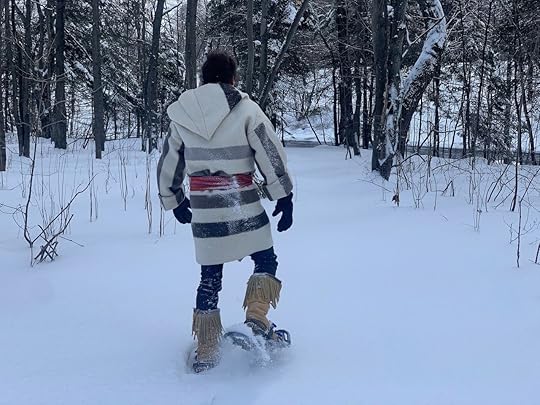
Photo: Laura Reilly
An important aspect of traveling to Canada is acknowledging that the land originally belonged to the First Nations, and their people and diverse cultures are still very much active. In Quebec, the main First Nation is the Wendake. Dedicate a whole afternoon to visiting the Huron Wendat community, which houses an interactive museum, a delicious restaurant featuring inventive First Nations cuisine (think bison sausages and crispy anoint fish), and many educational activities. Wendake guides can take you snowshoeing through the forest (the Wendake are known for making snowshoes), leading you to an authentic and truly massive longhouse.
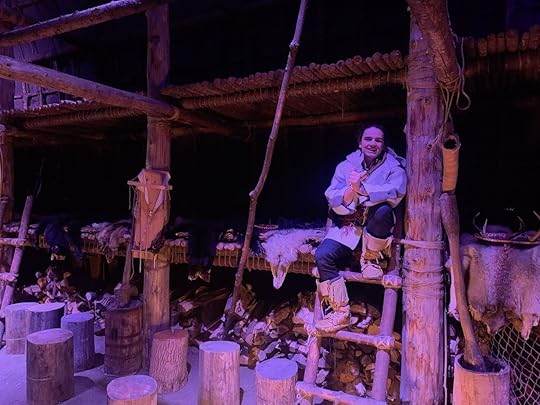
Photo: Laura Reilly
Over a fire, your guides will tell you more about their lives, history, and traditions, which include an enviable matrilineal society. They might also teach you how to make and roast bannock (fry bread) over the fire, like one would a marshmallow, and pair it with blueberry jam for dessert. Wendat Huron also hosts special events throughout the year that you can book in advance, like animal skin workshops, dances and ceremonies, and oral legends. Groups can even stay overnight under warm furs in the longhouse.
Do a yoga session in a restored monastery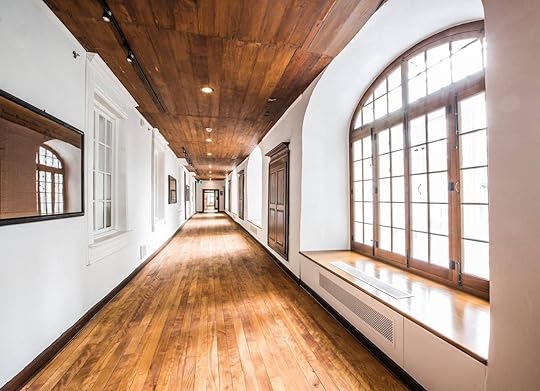
Photo: Le Monastère des Augustines/Facebook
In the 1600s, the Augustinian sisters arrived in Quebec City and established one of the first hospitals in North America. The historic walled monastery has since been restored and converted to Le Monastère des Augustines, a bright and airy wellness hotel honoring the sisters’ legacy of health. Visit for the day to take a yoga class or meditation session, explore the museum, and dine at the health-minded restaurant, topped off with one of their signature restorative herbal teas. For a more unique experience, stay overnight in one of the “authentic rooms,” extremely tiny cell-like rooms that used to house monastery guests and sisters, complete with antique furniture and other monastic architectural touches. If the thought of joining the nunnery gives you anxiety, opt for a contemporary room, which is still very simple but with more space and modern amenities.
Slide down in an ice toboggan in Quebec City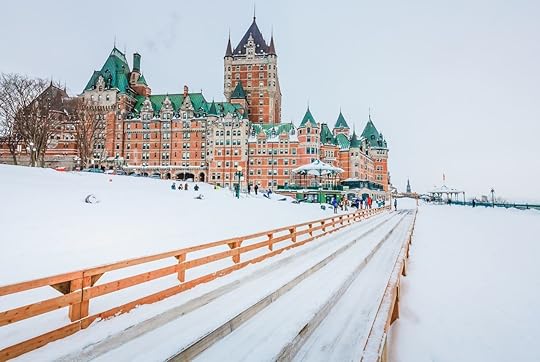
Photo: iPIX Stock/Shutterstock
Vieux Quebec, or Old Quebec City, might be the most charming neighborhood in all of North America. Colorful doors and windows pop against adorably quaint brick buildings, and every corner begs you to take another photo. In the winter, the snow and holiday lights maximize the enchanting effect. You can spend an entire afternoon popping in and out of shops, but the most fun activity awaits in Upper Town Quebec. (The city lives on two very distinct levels; skip the icy and steep stairs and ride the funicular up and down instead.) Grab a ticket for the historic toboggan, a century-old slide on the Dufferin Terrace outside of Le Château Frontenac. With average speeds reaching over 40 miles per hour, you’ll be screaming like a kid the entire way down — not least because the toboggan precipitously overlooks the St. Lawrence River, and you can’t help but feel, irrational a though as it may be, like you may be launched into its icy, watery depths.
Treat yourself to drinks at Le Château Frontenac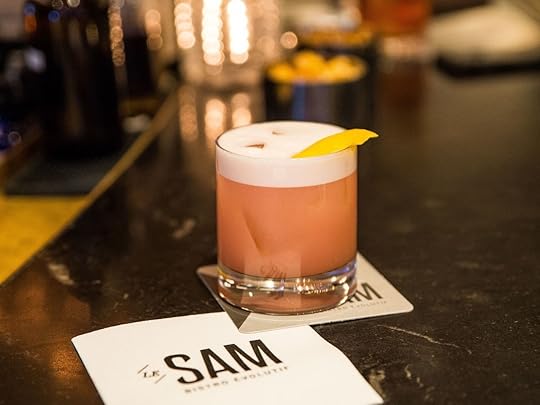
Photo: Le Sam, Bistro Evolutif/Facebook
The iconic Le Château Frontenac, a Fairmont property, has hosted some of history’s most famous celebrities and world leaders — with many framed photographs throughout its halls and a hefty price tag to prove it. If you can afford a stay here, by all means, splurge. You can even stay in suites themed to past guests like Winston Churchill, Princess Grace, and Celine Dion. But a cheaper option would be to grab drinks and a cheese board at Bistro Le SAM, the hotel’s more casual, though still fancy, offering. The panoramic view of the St. Lawrence River is breathtaking day or night, particularly when snow is falling. Look to see if there are any seasonal craft cocktails on the menu that feature honey. The Frontenac has a large rooftop garden and apiary with nearly 70,000 bees that produce over 600 pounds of honey, which is harvested a few times a year and used throughout the restaurants. The hotel also offers a lovely afternoon tea if you’d rather experience the stunning property in the daytime.
Indulge in comfort food — vegan or very much not vegan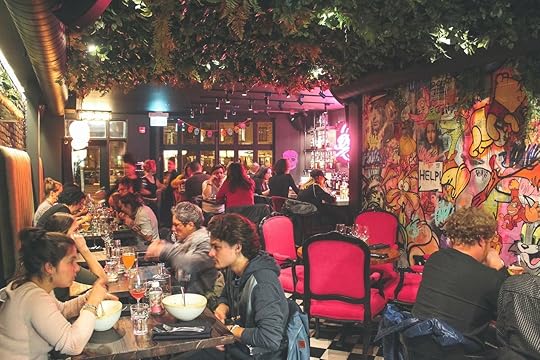
Photo: Don Vegan/Facebook
If you’re steadfast in maintaining your new year’s resolutions to be healthier or stick to a plant-based diet, Quebec City will not leave you starved for exciting options. Don Vegan, with its black brick and graffitied walls and neon pink lights, feels more like a dive bar than a vegan eatery. The menu also eschews raw salads and dainty grain bowls for decadent risotto, dumplings, and chocolate cake. It’s a tad healthier than your average French-Canadian meal but no less satisfying.
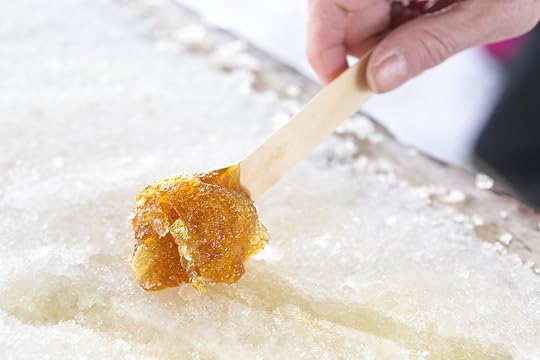
Photo: DGPICTURE/Shutterstock
But remember, life is all about balance. It would be a sin to leave Quebec without trying some proper cheese-curd-and-gravy-lathered poutine, and every local will have strong opinions on the best place to get them, but it’s up to you whether you want to go classic at Chez Ashton or more inventive at Poutineville or Le Chic Shack. For extra rich traditional French cuisine, head to Le Lapin Sauté, which specializes almost exclusively in rabbit dishes.
Wintertime in Quebec also means maple-flavored everything, and you’ll find it infused into just about every baked good. Maple syrup taffy candy is the move if you can hunt it down. This Quebecois treat is made by pouring hot maple syrup over freezing cold snow, wrapped and solidified around a popsicle stick. It’s tricky to find on a regular day, but there will definitely be street vendors selling them if you’re in town during the holidays or the Winter Carnival.
Brave a night in an ice hotel
Photo: Laura Reilly
There is nothing more spectacular about Quebec in wintertime than Hôtel de Glace. A seasonal feature of the Valcartier resort, it’s the only ice hotel in North America. Architects, engineers, and artists use tons of snow and crystal-clear ice to create this labyrinth of intricately designed rooms. Visitors can peek inside the themed rooms and have a drink at the ice bar, but overnight guests have the most brag-worthy experience. Once the daily tourists leave, guests have the run of the place. That means unlimited rides down the ice slide, all the time in the world to pose on the throne of ice, and trips between the outdoor hot tubs and saunas.

Photo: Laura Reilly
Just prepare for a truly chilly overnight, in case that wasn’t obvious. Dress like you’re going camping and pay attention to the mandatory orientation on how to set up your sleeping bag. If you get too cold in the middle of the night, you can always bail (a stay in a real hotel room inside Valcartier is included). But if you can stay zen and embrace the frosty abode, you’ll fall asleep in startlingly complete silence — and have a story to tell long after you return from Quebec. 
The post Why Quebec is the ultimate spot for a winter wellness getaway appeared first on Matador Network.

Things to do on Senja Island, Norway
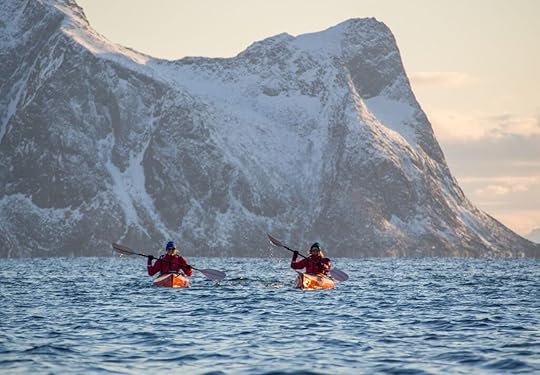
Far above the Arctic circle lies a seldom-visited region of Norway: the island of Senja. Its fjords are so deeply carved from millennia of Atlantic erosion and its interior so incised by receding glaciers that it looks more like stitched together fingers of land than a single island. But that craggy, ice-etched landscape holds impossibly angled peaks, copious lakes, inlets, bays, and stunning, otherworldly views. It packs so much into its 612 square miles that it is often called “Norway in miniature.”
One thing Senja has not so much of is people. As yet unknown to most travelers who seek out the neighboring Lofoten Islands due south, Senja offers so much solitude that you’ll wonder how you arrived there with so little fuss. And whether you go in winter to chase the northern lights or in summer to savor endless sunshine in a majestic landscape, you’ll find an array of ways to take in the vistas and locals ready to help you with that endeavor. Norway has myriad outdoor places to savor its ethos of free air living, and Senja is one of the most remarkable among them.
Chasing the northern lights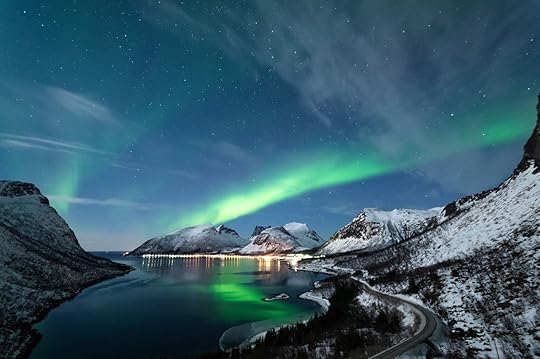
Photo: Nordicyigit/Shutterstock
Located over 180 miles north of the Arctic circle, Senja gets its share of dark winter nights during which to seek out the aurora borealis. While no trip to northerly regions is going to guarantee you’ll see the northern lights, you can always try and gauge your chances by looking up an aurora forecast from places like NOAA. The good news for those who are traveling north in the winter for the first time is that the colors in the sky are mesmerizing, even if they aren’t produced by the sun’s ions colliding with Earth’s atmosphere near its polar magnetic field. That’s because, with the sun lying so low to the horizon, and from mid-November to mid-January never cresting it, you end up seeing dazzling sunrise/sunset colors for several hours. When the black sky of early morning gives way to a deep, long-lasting purple as the day ever so slowly brightens, while oranges and reds blaze on the horizon, you will find the daytime sky as worthy of your attention as the illusive evening aurora.
That said, if you want to increase your chances of seeing the northern lights, you could sleep in a glass hut in a place like the Aurora Borealis Observatory hotel. But if you don’t overnight in a glass hut there, or at another hotel, don’t worry. At whatever accommodations you stay, the front desk is likely to have a list of rooms to call should the northern lights make their dazzling appearance; just make sure your name is on that list.
Getting out on the snow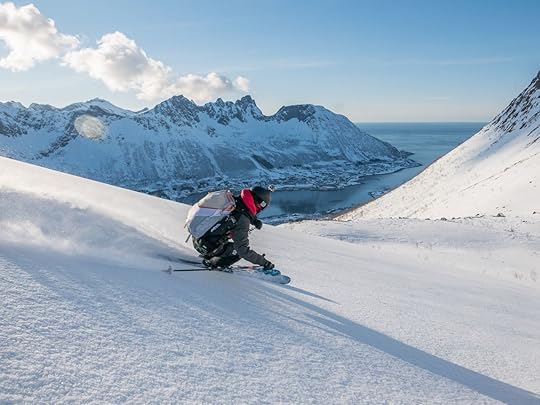
Photo: Visit Norway + Pete Oswald
You won’t find a single chairlift or gondola in Senja, but the skiing is spectacular. Fresh, untracked powder bedecks 3,000-foot peaks that soar right up from the Atlantic Ocean. Because of the fierce winter’s darkness, the ski season actually starts in February and can run as late as May. While plenty of multi-day ski expeditions can be organized by alpine guides who will also be flying into the area, you might prefer to hire a local guide for a single day of ski touring through a place like Hamn i Senja resort. The price is about 4500 NOK ($525) for one guide who can take between two and six people.
If snowshoeing is more your speed, it’s likely your winter accommodations will be able to source you a pair of snowshoes and indicate a wonderful, view-filled route. If you’re up for a guided tour, through the Hamn i Senja resort you can join easy or moderately challenging tours as early in the winter as December.
Getting out on the water
Photo: Visit Norway + Pete Oswald
With so many fjords and lakes, water is everywhere you look in Senja, and the best way to get up close to it is in a kayak. Until just a few years ago, you had to rent your kayak in Tromso, but now you can reserve one for the day through the Hamn i Senja resort for 500 NOK ($58) or 800 NOK ($93) for a tandem one. Note that the resort calls paddling from February to April “winter kayaking,” so come prepared with warm attire. While the resort can arrange a guide for you if needed during the so-called “winter” months of spring, they have regular guided kayaking trips in the summer months that depart at 10 AM and midnight sun trips that depart at 10:30 PM. Note that the sun doesn’t set from mid-May to mid-July.
You can also explore the ocean, searching for seabirds and seals, on a boat tour. In the chillier months, ice fishing is also possible. Once the weather warms up, though, you may prefer to explore the quiet ocean inlets on a paddleboard, which can be rented from places like the Senja Arctic Lodge for 200 NOK ($24) for two hours.
Hiking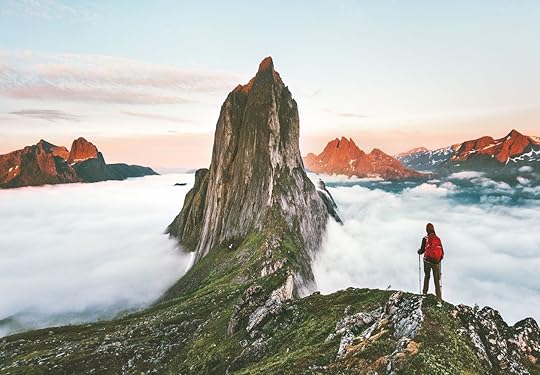
Photo: everst/Shutterstock
If nothing else, Senja’s neighbor islands to the south, the Lofotens, are known as an incredible summer hiking destination. Senja holds the same striking topography, with even moderate hikes like the 2.5-mile round-trip hike to the top of Sukkertoppen, which means sugar top, 1,500 feet up, offering breathtaking views nearly the whole way. Senja’s most famous hike summits Segla mountain; the demanding 2.5-mile round-trip takes you up nearly 2,000 vertical feet to a panoramic overlook.
The best time to plan hikes is after the month of July, as trails will likely be free of snow by then — and through September. Come late September, the weather may be less predictable. And given that so many of Senja’s hikes are on steep trails with sharp drop-offs, it’s critical to only hike with clear and dry weather. You need to be able to see the trails clearly and not find yourself on a slippery rock face during wet conditions.
Cycling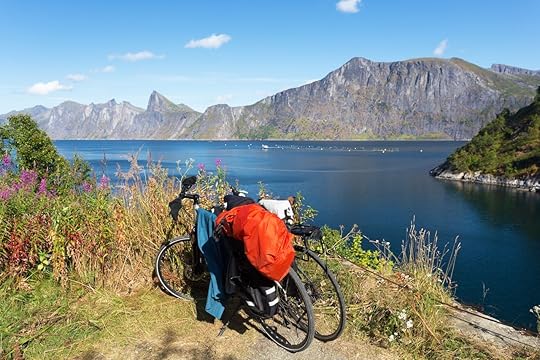
Photo: Lyakhova Evgeniya/Shutterstock
While less known for outsiders, cyclists from within Norway are increasingly drawn to the dramatic vistas, and hills, of Senja’s westerly side. They may cycle the portion of Norway’s National Scenic Route, which runs through Senja, but note that this one is full of thigh-busting ascents. If you aren’t planning a serious road-biking journey, you can also explore on a more relaxed touring bike rented through Hamn i Senja or, often, organized through your accommodations.
Relaxing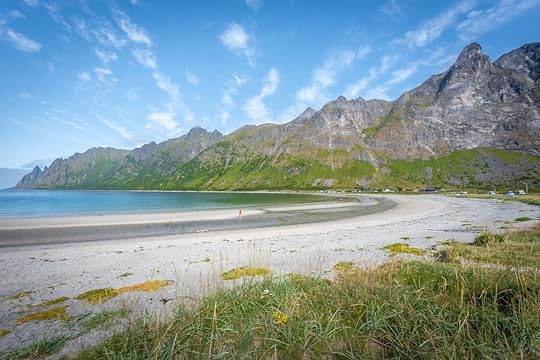
Photo: Inger Eriksen/Shutterstock
While Senja is idyllic for adventure lovers, it can also be a serene nature escape for those who wish it. While you may not choose to take a dip in the water by the beach, its aquamarine hue by the shore — one which seems more fitting somewhere closer to the equator — will nonetheless surprise you. In fact, Senja’s beaches are an excellent place for a summer amble, as is the wooden path that winds over the rocky coastline near Tungeneset. Some hotels offer hot tubs to linger in during the midnight sun or, in winter, cozy blankets to get under and peer out the north-facing windows in search of those iridescent northern lights. 
The post Norway’s Senja Island offers the perfect mix of adventure and solitude year-round appeared first on Matador Network.

Akutaq Alaskan ice cream: What it is

Charity Blanchett vividly recalls childhood visits to Tuntutuliak, the Yupik village in Alaska where her mother grew up: The day-long berry picking excursions and hauling ten-gallon buckets out into the tundra to fill with salmon berries and lowbush cranberries. The Honey Bucket outdoor toilet and the lack of running water in some homes that she says at first felt like “culture shock.” But what really stands out in her mind are the days her mother and aunties would gather in the kitchen to prepare akutaq (pronounced a-goo-duk). Her mother would spread cardboard on the floor and settle in front of a huge stainless steel bowl, into which she would mix the ingredients for this uniquely Alaskan dish.
Akutaq is a frozen dessert invented by indigenous Alaskans. It was originally a way to provide nourishment on long hunting or whaling trips out in the cold, inhospitable tundra where there isn’t much nutritious food to keep hunters warm and energized. The name akutaq comes from the Yupik phrase meaning “mix them together.” The traditional recipe is a fatty, creamy mixture of moose or caribou meat and fat, white fish like pike or cod, or seal oil, along with blueberries, salmonberries or cranberries, and ice. There’s also a version called green agudak that incorporates dandelion greens.
A University of Alaska Fairbanks Alaska Native Knowledge Network blog post on akutaq explains how sometimes a short ceremony is conducted after the akutaq has been prepared: The person who mixed the ingredients will draw the shape of a cross, and then take one of each type of berry and a “pinch of the mixture” and throw it into the fire while repeating the phrase “Tamarpeci nerluci,” or in English, “All of you eat.”
“There are a lot of indigenous families up north in Alaska who still practice subsistence living, so they live off their land, hunting, fishing, and gathering,” Blanchett tells me. “So when you put meat in agudak, it just makes it a bit more hearty for when you’re out there in the elements.”
Blanchett is a Yupik Eskimo and African-American woman, and akutaq was a staple in her childhood in Wasilla. Modern versions of the dish combine the fish or caribou fat and meat with Crisco (or replace the animal fat entirely) — an ingredient Blanchett speculates might have been introduced to indigenous tribes by settlers and missionaries.
No matter how it became such an accessible ingredient, Crisco has become a beloved addition to akutaq. Blanchett says her mother made her version with Crisco, sugar, raisins, tart salmonberries, and potato flakes to make it extra fluffy.
Blanchett’s parents made sure she and her siblings were well acquainted with both sides of their heritage. Both of her parents are pastors, and she attended many church potlucks at the African Methodist Episcopal Zion Church where she was baptized. Her mother spoke Yupik to the kids and they also received Yupik names. Blanchett’s is Qalutaq, which means dipping spoon, or as she explains it, “you dip into the water, the water is given to everyone, and it grows and keeps giving.”
If Blanchett’s school friends tried akutaq, it was probably at her parents’ house. For birthday parties, her mother would whip up big batches of akutaq by hand — no motorized appliances needed — alongside Western ice cream and cake. The family embraced and celebrated the Yupik way of life — both in and out of the kitchen. Her father built a traditional maqii steam bath in the backyard for her mother, as well as a smoker, so that she could prepare dried and smoked fish according to tribal custom.
“We ate moose and caribou meat instead of ground beef and whale muktuk, and my mother ate frozen white fish or pike dipped in seal oil. It’s quite pungent,” says Blanchett. “It’s so interesting to me that Japanese food is elevated to this grandeur, but indigenous Alaskan food is very similar. [Yet] it doesn’t get the same clout as Japanese cuisine. And I think that’s [due to] to Western ideals and colonization.”
Blanchett is keenly aware that the culinary industry — from who decides which cookbooks to publish, to who is hired for prestigious chef positions, to what dishes make it onto a menu or food-focused television show — routinely excludes and shuts out women of color and rejects their ideas and ambitions in the food world. That’s why she started The Dipping Spoon Foundation (a nod to her Yupik name), which provides scholarship opportunities for Black and indigenous women to attend culinary school at the New Orleans Culinary and Hospitality Institute, or train to become a food stylist, recipe developer, or food photographer.
Most of all, Blanchett believes in the resilience of indigenous people and in their ability to be creative innovators and survivors who will hold tightly to their traditions, even if it means thriving outside the culinary establishment. And perhaps those characteristics are best epitomized by the invention and continued devotion to akutaq among Alaskan native peoples. It’s a dish that exemplifies the industrious ways indigenous people have learned to make ingredients stretch over long periods of time, transforming them into foods that are healthy and sustaining.
“Depending on where you live in Alaska, summer is really short, but you have to have a full freezer and fridge,” says Blanchett. “I truly believe that indigenous people are so strong because we have to be. It’s a matter of survival. We’re so gritty because we have to survive the elements.” 
The post This savory Alaskan ice cream is made with berries, fish, and caribou appeared first on Matador Network.

Egypt’s first high-speed train
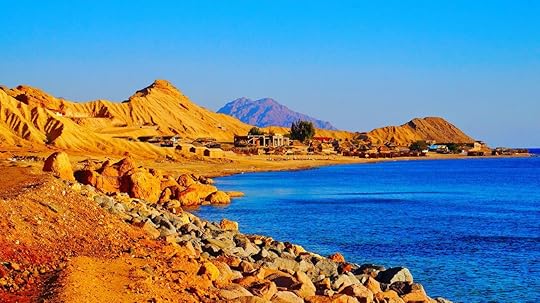
The first high-speed train line in Egypt is set to be built from the Red Sea to the Mediterranean, running for 621 miles. The route will pass through 15 stations, including a new unnamed “administrative capital” that will be the site of government buildings relocated from Cairo. The train line is being designed, installed, and maintained by German industrial manufacturing company Siemens, and it’s scheduled to be completed in two years.
Joe Kaeser, President and CEO of Siemens AG, said, “We are honored and proud to expand our trustful partnership with Egypt. By building a high-efficiency rail system for the country, we will support the Egyptian people with affordable, clean and reliable transportation.”

Photo: Siemens AG
Egypt was actually the first country in Africa with a train system, dating back to the 1850s, though this will be its first high-speed line. Currently, Egypt’s train network has over 3,100 miles of track connecting nearly every city and town, but the train system is out-of-date and underfunded, often resulting in deadly accidents. The country has been receiving monthly shipments of Russian-made train carriages as an upgrade, but the high-speed line will be an exponential improvement to domestic travel.
Egypt won’t, however, be the first country in Africa with a high-speed train. That distinction belongs to Morocco, whose Al Boraq train between Tangier and Casablanca opened in 2018. 
The post Egypt to build first high-speed train from the Red Sea to the Mediterranean appeared first on Matador Network.

National Plan For Vacation Day

Sometimes you don’t need a study to point out the painfully obvious, but it always helps to affirm your suspicions with hard data. It’s no surprise that people are craving a vacation now more than ever. According to a recent survey conducted by National Plan for Vacation Day (NPVD), people are incredibly hungry for a vacation right now, with 63 percent of respondents saying they “desperately” need a vacation.
NPVD is January 26, and the goal is to set aside a day at the start of the year to encourage people in the United States to plan their time off for the rest of the year. NPVD is also joining forces with the Let’s Go There initiative, a movement to encourage people to plan and book future vacations. A key part of the initiative is making sure workers actually take their PTO days.
According to the NPVD survey, 97 percent of respondents claimed that simply having a trip planned makes them happier, and 84 percent said they’re excited to plan a trip in the next six months. To join the global community of fellow trip planners, hashtag your travel plans with #PlanForVacation on social media, or follow the hashtag for inspiration. 
The post National Plan for Vacation Day is the time to nail down your next trip appeared first on Matador Network.

January 25, 2021
Most popular fast food chains abroad

We live in a consumer-driven world these days, where big brands dominate the economy and globalization means people have more access than ever to products from around the world. Despite our plethora of options, we still tend to flock to the same quick comfort foods no matter where we may be traveling. Some people frown upon indulging in fast food abroad, but those people are probably on hour six of a road trip and needlessly holding out for “local food” when there are several perfectly good Subways along the way. Fast food is an affordable, familiar, convenient option when you’re traveling, and every country does it differently.
The finance and lending research site BusinessFinancing put together a map showing the most popular fast-food brands in every country in the world. They used Google Keyword Planner to measure search volume data for top brands over the past year and identify the most-searched fast-food brand in each country.
Unsurprisingly, McDonald’s is the most-searched fast-food brand in the world, taking the number one spot in 75 countries. KFC is the most popular in 65 countries while Pizza Hut comes in at 28. It might surprise you to learn, however, that McDonald’s doesn’t dominate American search engines, with Pizza Hut truly capturing the hearts of US citizens. Canadians demonstrate their loyalty to a local chain by favoring Tim Hortons above all else, while Domino’s also makes a good showing in places like Australia, Mexico, and India.
If you’re planning an international trip and want to know what fast food you’re in for, check out the full map. BusinessFinancing also has more maps detailing the most popular consumer brands in each country, for those who wish to look beyond fast food. 
The post This map shows the most popular fast food chain in every country appeared first on Matador Network.

What does friluftsliv mean in Norway

If the past year has taught us anything, it’s that spending time outdoors is an escape that keeps us sane even in the toughest of times. The Norwegians have a term for this: friluftsliv. Pronounced free-loofts-liv, it loosely translates to “free air life.” It’s all-encompassing and can be widely interpreted. In winter, your idea of living life free of indoor confinement could be to quietly ice fish on a nearby frozen lake while a friend’s ideal scenario might be to strap on crampons and summit an icy peak. These very different activities both represent the “free air life” ethos.
As an American, I was curious if one can also channel the Norwegian spirit of friluftsliv through the power of prose? What if there was a book that evoked the spirit of the term nearly as well as the outdoors itself?
If so, then a top contender would be In Praise of Paths: Walking Through Time and Nature by Norwegian journalist and author Torbjørn Ekelund. An evocative personal narrative of time spent wandering through natural surroundings, In Praise of Paths perfectly captures the friluftsliv spirit, at least as I understood it. Ekelund recounts a wooded path from his childhood, showing how walking helped Ekeland cope with an epilepsy diagnosis that stripped him of his ability to safely drive a car and, more broadly, how nature can help us to find identity. Other paths appear throughout the book, some only metaphorical, all tying into the friluftsliv on which Ekelund has prioritized many of his life’s major decisions.
The book got me wondering how those of us on the other side of the Atlantic might add more friluftsliv into our lives. So I spoke with Ekelund to get his thoughts on the term’s meaning, how to achieve it, and on whether my outsider’s hypothesis that one could get frutisliv from a book was at all justified.
What friluftsliv means and how to capture its spirit this winter
Photo: everst/Shutterstock
“I’ve figured out that the story about travel is, in many ways, what you remember when you get home,” Ekelund told me over Zoom, adding that not only does he not write while traveling, but he also seldom even stops to jot down notes while on his frequent strolls. “When you walk along a trail or whatever kind of traveling you do, it disturbs the ability to observe,” he says.
Friluftsliv is to Ekelund not so much something you strive for but rather a fact of life, so long as some of said life is spent outdoors.
“It’s a word everybody [in Norway] is very familiar with. It means spending time in nature, without doing anything in particular. So if you go skiing, or if you go hunting or fishing, or just walking, everything is friluftsliv.”
My idea that prose could bring the friluftsliv spirit to life withered the further we got into our conversation. It became clear that to achieve friluftsliv, no book — no matter how adeptly it evokes nature’s beauty and power — can replace actually spending time outdoors.
“But [friluftsliv] has another meaning as well, which basically is to spend time in nature, which is synonymous with spending time away from the ‘normal’ life of city and work or whatever,” says Ekelund.

Photo: Greystone Books + Marte Garmann
The COVID-19 pandemic has accentuated this, Ekelund notes, as there hasn’t been much else to do — in Norway or any other place. “In my neighborhood here, which is in the outskirts of Oslo, people were walking all over the place all the time. They had fires in their gardens in the evenings, and I’ve spent a lot more time outside during this time.”
In winter, this often manifests itself as cross-country skiing. Ekelund is also very fond of winter camping, sans-tent, sleeping only underneath a tarp tied to surrounding trees, with a fire for warmth.
“In -14 Celsius, it gets really cold, so what you have to do is figure out not how to survive but how to manage and make it as comfortable as possible,” he says. “You learn a lot about nature when you do it. It’s learning by doing. I really enjoy that kind of friluftsliv when you’re trying to figure out how to manage life in nature.”
The takeaway for those of us who prefer tarp-covered slumber in warmer climes is that winter friluftsliv might take a bit more effort than that of warmer seasons, but it’s that effort that makes it worth it. Just get out there — on snowshoes, on cross-country skis, in a tent, or on the chairlift, and let your mind slip away from daily stressors.
How to friluftsliv to your life if you live in a city“The first thing to start with is to start looking more around you,” Ekelund says. “There’s nature all around, even in the centers of big cities. Central Park in New York is probably bigger than most forests in the area around my city. Try to observe and see even the tiny places.”
Even if you do live in a city, all it takes is a willingness to walk out your front door and look up. The birds, the trees — enjoying anything natural is inherently friluftsliv. If possible, spend the night somewhere, even if that somewhere is a few minutes away from your home. “Spending a night outside makes everything more exotic,” Ekelund says. “Maybe you’re a bit scared of the dark, maybe it’s a bit spooky, you’re not quite sure what equipment to bring. But if you do it once, you will learn a lot, so when you do it the second time, you will feel a lot more experienced.”
Adding friluftsliv into your lifestyle then becomes something that gets easier the more you do it and becomes ingrained in you, kind of like how to flip an egg or ride a bike. Don’t be intimidated; just go.
“It’s easy to think of nature as something big and undisturbed, but still there are things going on everywhere,” Ekelund says.
Develop a mindset of conservationBack to my query from above, I learned from speaking with Ekelund that there is one way to add more friluftsliv into your life even when you aren’t outdoors: maintain a focus on conservation.
“At a very early age, both my parents and my grandparents taught me about being respectful when you’re traveling in nature,” Ekelund says. “So when all this became more urgent in the past 10 years with climate change, it was a very natural thing for me, a thing I’ve always thought about. It has to do with a view of nature and our place in it.”
One should, he adds, have respect for all living things and be observant when it comes to the small things in nature. Ekelund brings this to life through a digital publication he co-founded along with three other veteran Norwegian journalists, Harvest. The website focuses on outdoor recreation and conservation issues in Norway and came to life largely due to its founders’ pursuits of friluftsliv — fly fishing in Ekelund’s case — as he wanted to better tell the stories of the sport he loves.
In the United States, we’re fortunate to have millions of acres of public lands to enjoy, along with state and neighborhood parks, even down to the walking path behind our home. Friluftsliv itself will always be an outdoors pursuit — but the power of prose and a book as thought-provoking as In Praise of Paths can help inspire us to get out there. After all, we all have to start somewhere. 
The post Norway’s friluftsliv is like hygge for outdoor lovers appeared first on Matador Network.

The best vegan skincare brands

Matador may collect a small commission from the links on this page if you decide to purchase one of the products recommended here.
Vegan skincare brands have become so overwhelmingly popular that you’ve probably already purchased something online without even knowing it was plant-based. But there are some vegan brands that have dedicated their entire line to being cruelty-free and are producing some outstanding products — products that are 100 percent natural but do the same job as those using animal byproducts such as beeswax or lanolin.
Making sure your skincare regime is as kind as possible to your skin and to animals and the planet is a simple adjustment and it’s just as important to keep up when you’re on the road as it is when at home. Traveling can put a real strain on your skin and present new problems such as dehydration and congestion, but with a stable regime of plant-based products, these troubles can be diminished. From hydrating natural oils to cream cleansers to gel masks, here are some of our favorite vegan skincare products.
1. Pai Skincare
Photo: Pai Skincare/Facebook
Pai Skincare is a great starting point for anyone who wants to upgrade their regime. Its product line is really extensive, its marketing and packaging is easy to understand, and it’s affordable. The ingredients in its products are clearly listed and transparent about why each element has its place.
Pai’s vegan skincare products are ideal for anyone like me, who suffers from very sensitive, rosacea-prone skin. Its camellia and rose gentle cream cleanser, which is alcohol-free, is so calming and packed with three natural oils that cleanse the face without stripping it bare. It’s a classic and should be used daily, and it’s a great investment if you’re planning a trip to a polluted city. Another favorite is Pai’s rosehip oil. Harvested from the seeds and fruit of rosehips, this cold-pressed oil is a go-to for aiding anti-aging, calming acne-prone skin, and reducing scars. This is one of Pai’s bestselling products and has a ton of five-star reviews. It’s super hydrating, so it’s great to pop in your carry-on for flights.
2. Odacité
Photo: Odacité/Facebook
Odacité is the brand to turn to if you have problem skin. Let’s face it, when traveling and being exposed to different climates and food, those of us who suffer from skin issues seem to get the short end of the stick. Odacité is 100 percent vegan and its serums are game-changers. You only need a few drops of concentrate in your daily regime — and we mean daily. Although Odacité’s products and all others listed here are perfect for travel, to see any marked difference in your skin, you need to be religious with your application and give things time.
With that said, start with its energy face serum with blueberry and jasmine oil, or if you have dry skin, look into the concentrate with moringa and petitgrain. The latter is packed with essential fatty acids and antioxidants from moringa oil and petitgrain works in synergy bringing a hydrating action to your skin.
3. PLANT Apothecary
Photo: PLANT Apothecary/Facebook
PLANT Apothecary is a no-frills range and that’s exactly what Brooklyn-based co-creators Bjarke Ballisager and Holly McWhorter wanted to achieve. They set out to make a vegan, natural brand that was accessible to a huge range of skin types. This is another collection that will not break the bank with products starting around the $16 mark.
We love the multi-purpose aloe and lemongrass face wash, which is packed with essential oils and lightly scented. It’s free of parabens, sulfates, and all other synthetics and is gentle on all skin types.
4. Skyn Iceland
Photo: skyn ICELAND/Facebook
Skyn Iceland is one of the best vegan skincare brands for sheet masks. Personally, I’ve been purchasing its masks even before I shifted my regime to plant-based and boy am I happy to see them stay.
Another favorite is the eye Hydro Cool Firming Gels, which come in handy to help get rid of puffy dehydrated eyes after a long-haul flight. There are also multipack boxes of what are called “face-lift” gels. This pack gives you the option of gels for three problem areas — forehead, smile lines, and under the eye — and promises a lifting and plumping effect for up to 24 hours.
5. Youth to the People
Photo: YOUTH TO THE PEOPLE/Facebook
Making sure your skincare regimen includes Youth to the People is like making sure you hit the gym and have a green juice once in a while. It utilizes superfoods such as kale and spinach and others packed with vitamins, minerals, antioxidants, and phytonutrients, and injects the cold-pressed plant extracts properties into its iconic skincare products.
While we could really go to town listing out some of the standouts, it might be wise to start with the duo mini skincare kit which includes a gel foaming green tea cleanser and kale and spinach moisturizer. Both of these are bestsellers and work together to purify, hydrate, and visibly brighten your skin. Another to look out for is the Superberry Hydrate + Glow Mask. This overnight mask is ideal for use during long-haul flights. It hydrates, plumps, and brightens with the use of vitamin C and has a ton of antioxidants.
6. Herbivore Botanicals
Photo: Herbivore Botanicals/Facebook
All of the brands listed above make sure that every single ingredient has a place and some specific therapeutic reason for being in their products, but Herbivore Botanicals is really passionate about this importance. It has zero filler ingredients and each product has a highly concentrated and effective formula. This basically means that there is nowhere to hide and that kind of transparency is very welcome, especially if you’re testing the waters with vegan skincare.
Its bestsellers include a retinol alternative with naturally derived Bakuchiol serum and its rosehip oil. But we adore the body range specifically. Ideal after a long day of travel or just to pep up your hotel tub, the calming bath salts are a blend of Himalayan pink salt infused with ylang-ylang and vanilla. Another choice pick is the coconut milk bath soak, which is hydrating and luxurious. 
The post The 6 incredible vegan skincare brands you need to travel with appeared first on Matador Network.

Matador Network's Blog
- Matador Network's profile
- 6 followers



